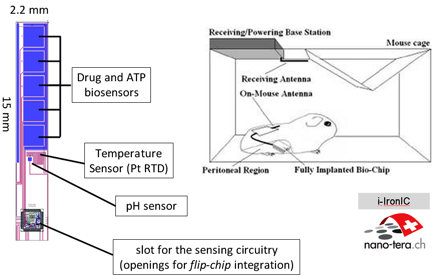Go to
Andrea Cavallini
PhD Student, Integrated Systems Laboratory, Swiss Federal Institute of Technology, Lausanne, Switzerland
Implantable Platform for the Sensing of Bioactive Molecules in Personalized Therapy
At present, the most common clinical practice is the so called trial and error medicine1. This approach, which is time consuming and expensive for both the patient and the health care system, is beneficial only to 20-50% of individuals, while 7% experience severe adverse drug reactions2. Breakthrough targeted therapies could save many lives and a great deal of money. Pharmacogenomics, which considers the unique patient’s genetic polymorphism, represents a first step towards personalized medicine. However, lifestyle and drug interactions, which cannot be predicted with genetics, also play an important role in influencing the drug response. A system based on the direct monitoring of bioactive compounds in the human tissues could represent a more accurate alternative to the pharmacogenomics.

P450 proteins represent good candidates for the realization of biosensors for drug detection. These cytochrome isoforms account for the 75% of body metabolism3, and often mediate the rate-limiting steps in the biotransformation of xenobiotics. ATP is a multifunctional nucleotide used by cells as an energy source for many important reactions, its extracellular concentration plays a critical role in the physiological regulation of inflammation and in the protection of tissues from excessive damage4.
In this project, we propose an implantable system designed to monitor the drug concentration and the inflammation status in the human tissues. The platform measures 15 x 2.2 mm, and hosts 5 different platinum microelectrode arrays for the biosensing of bioactive compounds. The device passivation is done with Al2O3, a biocompatible material. Metabolites are sensed electrochemically: P450 proteins and cyclic voltammetry are employed to identify and quantify the drugs in the sample; glucose oxidase/hexokinase and chronoamperometry to follow the ATP concentration. Other two sensors are used to monitor fluctuations in temperature and pH that can affect the electrochemical response of enzymes during drug and ATP biosensing. Carbon nanotubes are cast on the microelectrode arrays to improve the sensitivity and the detection limit of the biosensors. Moreover, the platform is designed to host a microchip capable to perform all the electrochemical measurements and an antenna for the remote powering of the device and the data transmission.
1M. Aspinall and R. Hamermesh, "Realizing the promise of personalized medicine," Harvard Business Review, vol. 85, p. 108, 2007.
2J. Lazarou, B. Pomeranz, and P. Corey, "Incidence of adverse drug reactions in hospitalized patients: a meta-analysis of prospective studies," Jama, vol. 279, p. 1200, 1998.
3F. Guengerich, "Cytochrome p450 and chemical toxicology," Perspective, vol. 21, p. 71, 2008.
4M.V. Sitkovsky, D. Lukashev, S. Apasov, H. Kojima, M. Koshiba, C. Caldwell, A. Ohta, M. Thiel, Annu. Rev. Immunol., 657 (2004)
About the Speaker:
 Andrea Cavallini received a bachelor's degree in Pharmaceutical Biotechnology at the University of Ferrara and a master's degree in Molecular Biotechnology at the University of Bologna. Currently, he is a PhD student in Microsystems and Microelectronics at the Swiss Federal Institute of Technology in Lausanne (EFPL), under the direction of professors Sandro Carrara and Giovanni de Micheli.
Andrea Cavallini received a bachelor's degree in Pharmaceutical Biotechnology at the University of Ferrara and a master's degree in Molecular Biotechnology at the University of Bologna. Currently, he is a PhD student in Microsystems and Microelectronics at the Swiss Federal Institute of Technology in Lausanne (EFPL), under the direction of professors Sandro Carrara and Giovanni de Micheli.
His main research interest focuses on the development of point-of-care and implantable cytochrome P450-based nanochip arrays for diagnostic applications. He also has research experience in the characterization and biofunctionalization of thin films for the realization of label free DNA microarrays based on capacitance detection.
Secondary navigation
- EPFL Workshop on Logic Synthesis and Emerging Technologies
- Luca Amaru
- Luca Benini
- Giovanni De Micheli
- Srini Devadas
- Antun Domic
- Rolf Drechsler
- Pierre-Emmanuel Gaillardon
- Jie-Hong Roland Jiang
- Akash Kumar
- Shahar Kvatinsky
- Yusuf Leblebici
- Shin-ichi Minato
- Alan Mishchenko
- Vijaykrishnan Narayanan
- Ian O'Connor
- Andre Inacio Reis
- Martin Roetteler
- Julien Ryckaert
- Mathias Soeken
- Christof Teuscher
- Zhiru Zhang
- Symposium on Emerging Trends in Computing
- Layout synthesis: A golden DA topic
- EPFL Workshop on Logic Synthesis & Verification
- Luca Amaru
- Luca Benini
- Robert Brayton
- Maciej Ciesielski
- Valentina Ciriani
- Jovanka Ciric-Vujkovic
- Jason Cong
- Jordi Cortadella
- Giovanni De Micheli
- Antun Domic
- Rolf Drechsler
- Henri Fraisse
- Paolo Ienne
- Viktor Kuncak
- Enrico Macii
- Igor Markov
- Steven M. Nowick
- Tsutomu Sasao
- Alena Simalatsar
- Leon Stok
- Dirk Stroobandt
- Tiziano Villa
- Symposium on Emerging Trends in Electronics
- Raul Camposano
- Anantha Chandrakasan
- Jo De Boeck
- Gerhard Fettweis
- Steve Furber
- Philippe Magarshack
- Takayasu Sakurai
- Alberto Sangiovanni-Vincentelli
- Ken Shepard
- VENUE
- Panel on Circuits in Emerging Nanotechnologies
- Panel on Emerging Methods of Computing
- Panel on The Role of Universities in the Emerging ICT World
- Panel on Design Challenges Ahead
- Panel on Alternative Use of Silicon
- Nano-Bio Technologies for Lab-on-Chip
- Functionality-Enhanced Devices Workshop
- More Moore: Designing Ultra-Complex System-on-Chips
- Design Technologies for a New Era
- Nanotechnology for Health
- Secure Systems Design
- Surface Treatments and Biochip Sensors
- Security/Privacy of IMDs
- Nanosystem Design and Variability
- Past Events Archive

